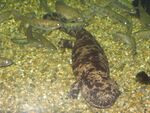Newt
The womb newt or simply newt (Notophthalmus uterius) is a lizard shaped amphibian often confused for a salamander. Newts tend to be larger than most salamanders, although the giant Asian salamanders are much larger than the newt. Additionally, newts retain their gills in adulthood, while most salamanders do not.
However, newts and salamanders are most easily distinguished by their natural habitats. While the salamander is primarily a semi-aquatic or aquatic creature, the newt lives solely in the uteruses of human females. It is one of the largest parasites found in the human uterus, exceeded in size only by the fetus (Homo sapiens sapiens).
Lifecycle[edit]
In earlier times, it was commonly believed that storks inserted newts in the uteruses of females for reasons unknown. It is now known that the vast majority of newts are inserted into uteruses by pelicans and cranes: storks only insert 5-10% of newts. The young newts begin their life cycle as oral parasites of large sea birds, feeding on fish and the like. As the newt grows larger, it will eventually because a nuisance to the host bird, who will try, but rarely succeed, to dislodge the newt. Many species of birds will then seek a human female host in order to rid itself of the newt. Alternatively, the newt may leave on its own if it notices a suitable human host nearby.
The newt will then attempt to force its way into its adult natural habitat, i.e. the human uterus. The newt can become quite aggressive if the female resists, but will generally avoid harming its new host if possible. The newt will generally remain in the human uterus for the rest of its life. However, it will leave on the death of its host or when its host reaches menopause, if it is forced out by a more powerful newt, or rarely, if it discovers a better host female human.
Effects on Host[edit]

The newt's entry into its host will nearly always significantly stretch the uterus of the host female human. This is generally painful, although less so if the host's uterus has been stretched by another parasite, such as another newt or a fetus. This also forces the female abdomen out significantly, often requiring the host female to purchase new clothing.
Historically, the stretching of the female's abdomen has been regarded as unattractive in western cultures. However, the expanded uterus does tighten the abdomen, smoothing out minor fat rolls, and newt-stretched abdomens are less taboo than in the past. Additionally, some anthropologists assert that human males inherently find the stretched abdomen active, as it proves the female in question has a functioning uterus and is therefore fertile.
Benefits[edit]
While the womb newt is often regarded as a parasite, it does provide some benefits to the host, mainly in repelling other uterine parasites. The womb newt is noted for his tendency to devour smaller parasites of the human uterus, including mice, eels, and the occasional vagrant spleen weasel. Additionally, the womb newt also keeps the dreaded fetus from occupying the uterus.
Formerly, it was commonly believed that the newt prevented fetus infestation by devouring the fetus. Although it is true that the newt will devour a human fetus if given the chance, in almost all cases, the womb newt prevents the fetus from even developing.
The womb newt does this by viciously attacking the male penis whenever it is present near the uterus, possibly mistaking it for an eel, thereby preventing the fertilization of the egg from ever occurring. This obviously makes normal vaginal intercourse difficult or impossible for the host female, but has the advantage of preventing unwanted sexual intercourse.
Newt Removal[edit]
Historically, forcible newt removal has been considered immoral, and has often been illegal. Although forcible newt removal is legal in many western nations, it is still widely regarded as morally wrong and will result in ostracism in many societies. Generally, it is argued that the human female was given a uterus in order to provide a habitat for newts. Or in the words of a noted philosopher , "If the gods had not intended women to serve as host bodies for various parasites, why did they given women uteruses?"
See Also[edit]
| |||||||||||||||||||||||


